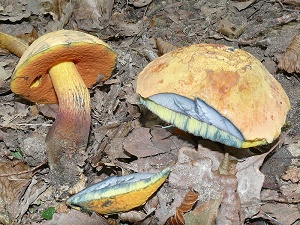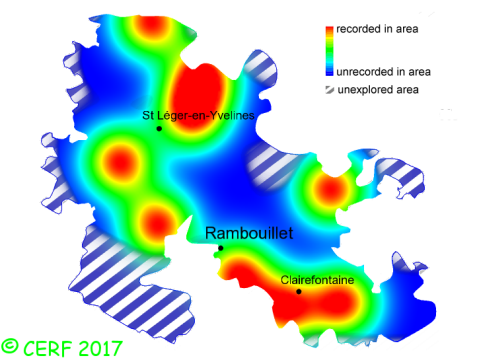| Boletus queletii Schulzer |
|
|
|
|
|
|
The cap is very variable in colour, never really brown, but in general yellow to red-brown, with shades of buff, orange, brick-red, pink. It turns blue or black when touched., convex then flattened. The cap surface is very finely pruinose (particularly towards margin) to velvety, then smooth, dry, fibrillose. The stem is irregular, crooked, cylindrical to spindle-shaped, tapering towards a pointy base almost rooting. It has a lemon yellow colour towards the top, becoming beetroot-red to blackish towards the base. It has no network, but it is spotted with red or orange dots.. The flesh is firm, lemon yellow in the cap, beetroot or purple red towards the stem base, the whole flesh turning blue immediately but not intensely when in contact with air; its taste is faint, sour; the odour is faint, sour; The tubes are ochre to yellow, turning blue when cut. The pores are narrow, round, yellow then orange-yellow to red, stained with dark blue when pressed. The spore print is olive brown. It grows in well ventilated deciduous woods, very rarely with conifers. It can be found more often in southern Europe, in grassy places, clearings, wood edges, solitary or in small troops, on a rather calcareous soil, with oak, hornbeam. The fruiting period takes place from June to November.
Chemical tests : The flesh turns greenish when in contact with ammonia (NH3). Distinctive features : beetroot-red stem at base and yellow at the apex; orange to red pores, tuning blue when pressed; stem without network, but dotted with red to orange dots Boletus queletii is infrequent and scattered in the forest of Rambouillet, and is infrequent, more generally speaking . | ||
|
page updated on 14/01/18

